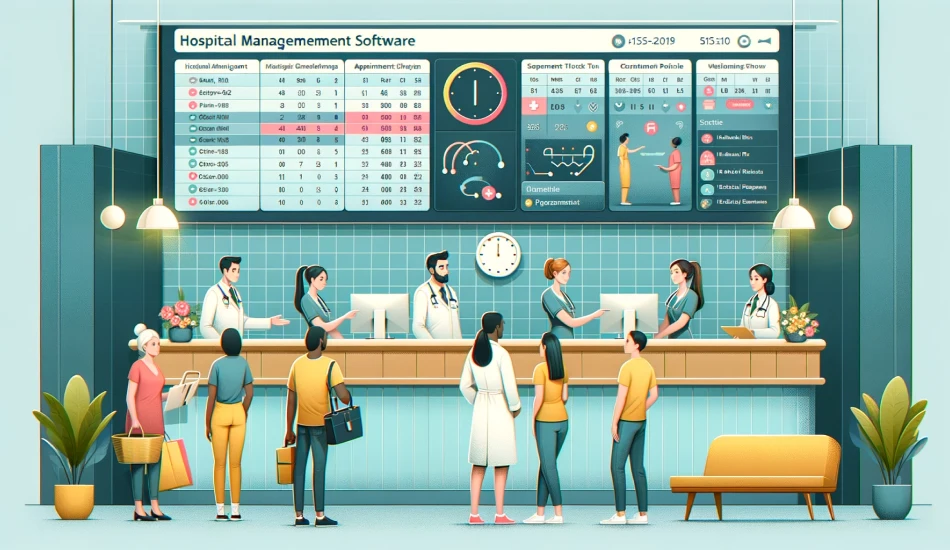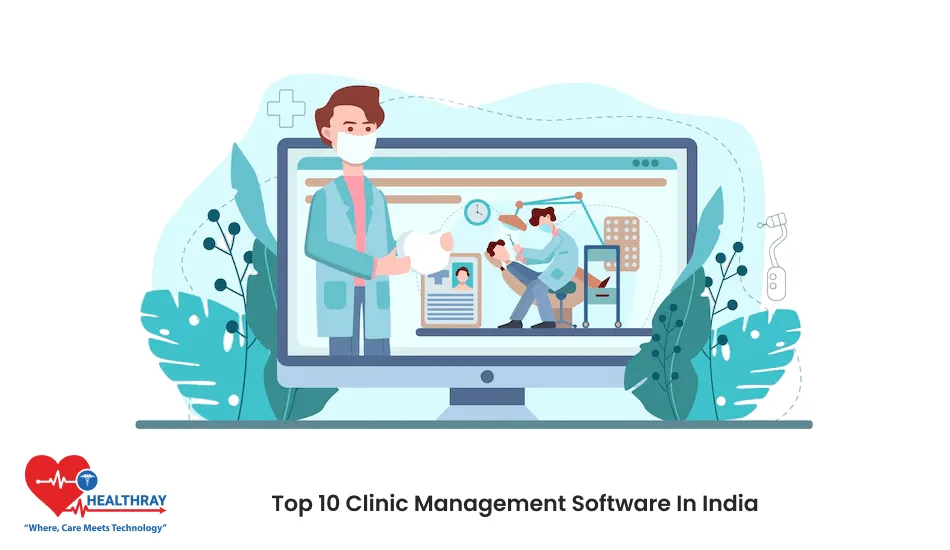Quick Summary: The use of a Hospital Management System can improve the operations of hospitals which is not easy. Here’s a guide to assist you for How To Create Hospital Management software. To read on for insights and steps towards creating effective hospital administration software, check this out!
Introduction
Creating a Hospital Management System is like creating a digital orchestra for the medical field. It goes far beyond simply managing tasks; also encompasses patient care improvements and maintenance of operational efficiency in healthcare institutions. Therefore, in this tutorial, we will walk you through step by step even if you are not so tech-savvy. So, learn How To Create Hospital Management Software.
Before explaining the development steps of hospital management software, let’s glance at the advanced functionalities. Ease to retrieve historical appointment information with the specific details. Furthermore, the hospital management system software creates reports, classifies data correctly, and improves revenue. Besides, it brings entire clinical, customer, and asset information on the single platform.
This system’s heart is the software that simplifies handling electronic medical records, booking appointments, billing and registering patients. This is a powerful instrument that improves the quality of health care rendered to both patients and professionals. More than just an ordinary tool.
Now let’s get down to developing the best possible hospital administration software! And remember that there are always organizations which develop software for hospitals available to help you expand your knowledge.
Continue reading for some insightful information!
What Is Hospital Management Software?
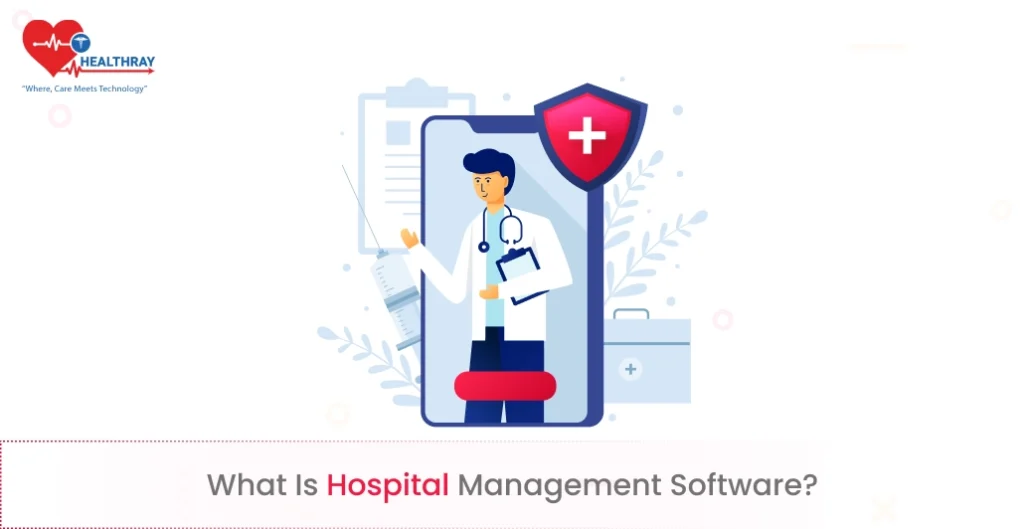
The very first thing we will discuss in this guide on How To Create Hospital Management Software, is the meaning of HMS. So, let’s understand the basics of hospital administration software before getting into the specifics of developing it.
Similar to a digital right hand assistant for hospitals and the larger healthcare sector, an HMS is an information management system. Consider it computer software with a purpose: to assist clinics and hospitals in keeping their affairs in order by keeping systematic records of everything
patient-related, including appointments, prescriptions, and more.
Manage healthcare finances from patient billing to employee salary. The hospital management system boosts client engagement rate, reduces data complexity, an efficient system for revenue growth. Furthermore, the hospital management software administrates resources well to improve cash flow, manage assets appropriately, and assign human resources in diverse departments. Therefore, it creates divergent graphical reports such as pie-charts, bar-graphs, donuts, and more.
The key to simplifying the daily bustle of hospital chores is this programme. Imagine a single, easily accessible platform where medical professionals and personnel can manage all patient information updates, appointment scheduling, invoicing, and payment processing.
It’s more than just a tool; it’s a complete solution that ensures healthcare facilities run efficiently so they can give their patients the best treatment possible. It’s necessary to choose the most suitable type of Hospital management System. Let’s now embark on the thrilling adventure of making this amazing digital creation!
Typical Features of Software for Hospital Management
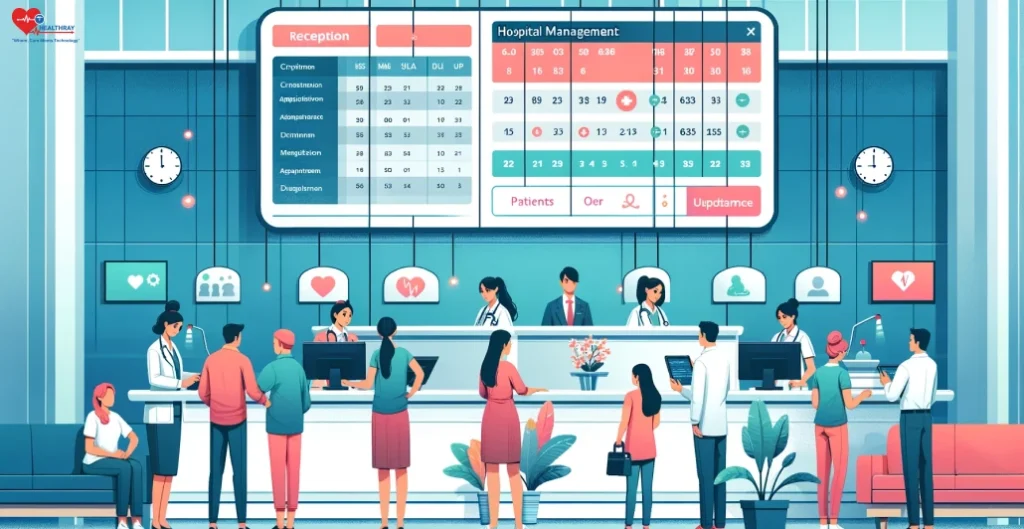
The developers are always confused about the EHR functionalities and they want a complete guide “ How to create an EHR software?” These attributes help you a lot.
This is an essential part of our guide on How To Create Hospital Management Software. So, let’s have a look at the advantages of Hospital management system:
Features of Hospital Management Software
- Patient Registration
- Appointment Scheduling
- Electronic Health Records (EHR)
- Billing and Invoicing
- Inventory Management
- Pharmacy Management
- Laboratory Management
- Radiology Information System (RIS)
- Financial Management
- Staff and Resource Management
- Electronic Prescriptions
- Telemedicine Integration
- Reporting and Analytics
- Security and Compliance
- Patient Portal
- Mobile Accessibility
- Alerts and Reminders
- Emergency Management
- Insurance Verification
- Integration with Medical Devices
- Emergency Management
The Essential Features That Every Hospital Management System Should Have
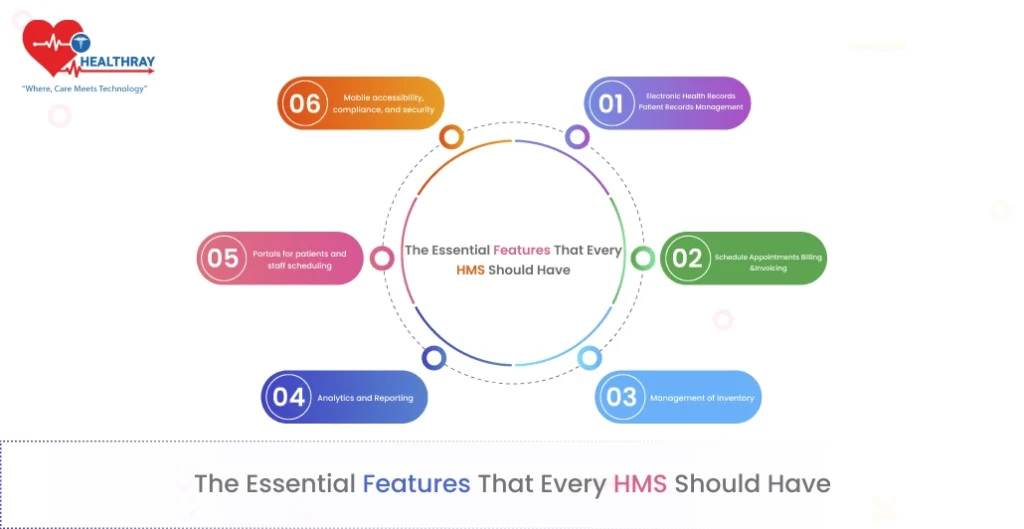
Hospital management software must include a number of essential elements in order to be genuinely useful and supportive for physicians and staff. Below is a summary of these crucial elements:
Features of HMS for Doctors:
Electronic Health Records (EHR) and Patient Records Management
- Improve care by managing the patient’s data effectively, minimize mistakes, and provide quick access.
- Electronic Health Records (EHRs) digitize patient information creating secure reusable files that enhance communication and save on paper work.
Scheduling Appointments, Billing, and Invoicing
- Appointment scheduling that ensures customer satisfaction and time management as well.
- We have also simplified billing and invoicing processes in order to reduce errors and make it easier for accounting purposes.
Integration of Laboratory and Test Results with Prescription Management
- Electronic prescription management for increased accuracy and decreased mistakes.
- Integrated with laboratory systems so that test results can be quickly accessed to facilitate diagnosis and treatment decisions.
Management of Inventory
- Strong inventory control must be put in place to ensure that essential medical supplies are always available thereby reducing disruptions to patient care.
Portals for patients and staff scheduling
- Effective staff scheduling is done such that there is enough manpower resource while still maintaining the quality standards.
- Patient portals facilitating safer communication, more active participation of patients, and online scheduling should be made accessible to all patients within a provider organization
Analytics and Reporting
- Powerful analytics and reporting capabilities allow decision-makers to gain valuable insights from their patients’ data.
Mobile accessibility, compliance, and security
- Data security protocols can significantly improve with regard to HIPAA compliance and private patient data protection.
- As a result of mobile responsiveness, patients can continue receiving healthcare services from medical personnel and employees who are away from their workplaces.
Support for Telemedicine:
- Support from telemedicine for online consultations that increase patient convenience and the reach of healthcare.
Interface that is easy to use, assistance and instruction, and personalisation
- Interface that is easy to use for a system that is straightforward and doesn’t require a lot of training.
- Resources for training, prompt customer service, and ongoing support are necessary for efficient system utilisation.
- Options for customisation allow the system to be adapted to the unique requirements of any healthcare facility.
These elements should be given top priority in hospital management software in order to increase the effectiveness of daily operations, enhance patient care, and simplify administrative procedures for medical personnel. It’s about enabling physicians and workers to deliver excellent care, not just about organising duties. Hospital contract management software can help you assist with managing workflow.
Must Have Features For Patients

In order to enhance patient experience and engagement, hospital management software should have various features that specifically cater for patients. These are some of the features which any patient must look out for in a hospital management software:
Features of HMS for Patients:
Online scheduling of appointments and patient portal
- A patient portal where patients can also reach test results, medical records or contact medical staff.
- Online appointment booking ensures shorter waiting times for patients and greater access to care.
Medical Records and Prescription Refills Accessible
- It gives ease of integrating or sharing medical records with other Health Care Providers.
- Online prescription refill requests help in adherence to medications.
Secure messaging, payment processing, and billing:
- Simple financial experiences alongside clear options for medical billing as well as payment alternatives.
- Efficient communication between doctors and clients is ensured by sensitive texts.
Resources for Health Education and Telehealth Services
- Telehealth services augment consultation from the distant to increase access to care.
- Health education resources such as articles and videos for self-care through wellbeing awareness are available
Reminders for Appointments, Check-In, and Registration:
- To enhance adherence and reduce no-shows there should be automated reminders for appointments.
- By ensuring a seamless registration and check-in procedure, a patient experience can become more effective.
Comments and Evaluations
- Incorporation of a system for patient reviews and comments to exchange experiences and improve services.
- Positive appraisals attract new customers while negative feedback creates opportunities for improvement.
Notifications & Alerts About Health
- Patients can get messages about appointments, prescriptions, or health on time.
Contacts for Emergencies
- This is a feature that allows the easy sharing of medical emergency contacts with doctors in emergency situations as a way of keeping patients safe.
Security and Privacy
- There are good security measures like protection of private EHR data and building confidence among patients who use such systems online.
Language preferences and accessibility on mobile devices
- Accessibility through mobile technology gives persons an opportunity to access health information from any locale using an app or a mobile friendly interface.
- Language preferences towards ensuring inclusive communication between patient and healthcare provider
Digital Waiting Area
- Remote waiting: Patients may wait from other locations in virtual waiting rooms that enhance safety and eliminate inconveniences associated with physical waiting areas.
These patient-centered elements promote patient participation, safety, happiness, while also making healthcare easier and more enjoyable. Therefore, it is important to place the patient at the center of their own healthcare experience. enjoyable. Therefore, it is important to place the patient at the center of their own healthcare experience.
Benefits Of Creating Hospital Management Systems
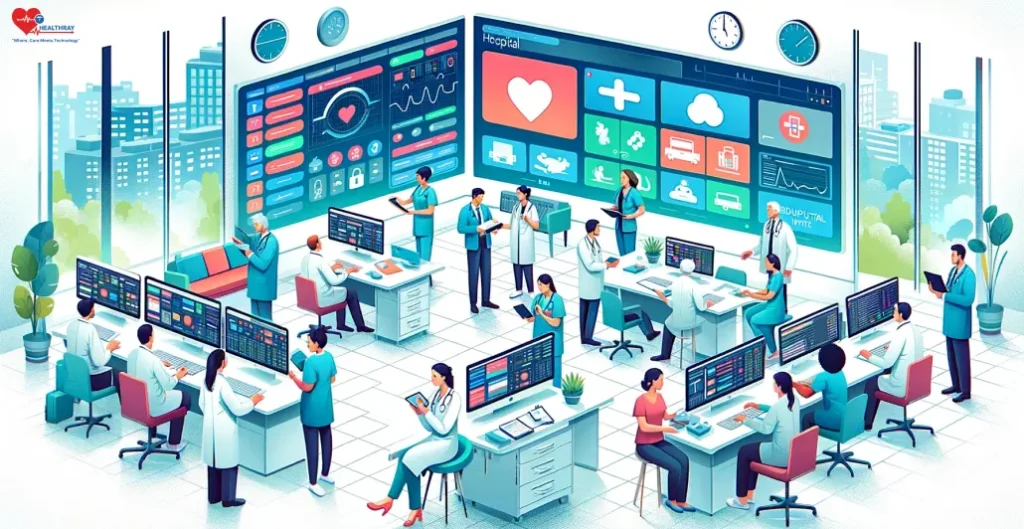
Before learning How To Create Hospital Management Software, let’s learn how will benefit you:
Effective Patient Care
Digitization of medical records simplifies the process of accessing patient information by doctors and nurses. Consequently, this leads to quick diagnosis, therapy and drug administration thereby improving patients’ health status and reducing waiting times.
Better Record-Keeping
Elimination of paper-based patient records reduces the possibility of errors occurring in healthcare. This ensures accurate, safe, and easily retrievable medical information promoting efficient treatment planning as well as smooth staff coordination.
Improved Communication
Real-time communication among healthcare providers is enabled through the Hospital Information Management System that hastens dissemination of emergency facts. Thus, it facilitates faster decision making processes and better collaboration between hospital staff regarding patients’ care.
Resource Optimisation
These systems help hospitals utilize their staff, beds and equipment most efficiently by examining data on patient admissions and discharges. Consequently, they allocate resources more efficiently thereby leading to cost savings as well as reduced wait times.
Billing and Financial Data Management
By automating billing procedures, the Hospital Management System reduces mistakes and speeds up the reimbursement cycle. This guarantees timely payment collection, which supports both the delivery of high-quality healthcare and financial stability.
Data analytics
The software used by hospital managers captures and analyzes patient information, treatment outcomes, and utilization rates. This data driven approach improves patient care and enhances hospital operations by enabling better decisions.
Patient Engagement
It has features such as online appointment scheduling, access to electronic medical records, and telemedicine that improve patient engagement. The hospital management information system allows for easier doctor visits which leads to more satisfaction with care and better communication.
Security and Compliance
HMS ensures the safety of private patient data using access restrictions and encryption. It also helps hospitals avoid legal trouble, maintain confidentiality of patients’ personal information, while conforming to rules like HIPAA
Inventory Control Management
This ensures effective inventory management resulting in decreased wastage and ensuring that healthcare facilities have the required materials as well equipment for treatment purposes. In addition it achieves financial savings along with improved patient results.
Remote Access
Employees of hospitals can perform tasks as well as view client data from a distance thereby improving productivity while at the same time enhancing quick response towards demands of clients in case of emergency situations.
Scalability
The HMS Systems can expand with hospitals to manage a higher patient volume. Its ability to quickly handle increased service demand makes it an excellent long-term investment in healthcare administration software.
Types of Hospital Management System
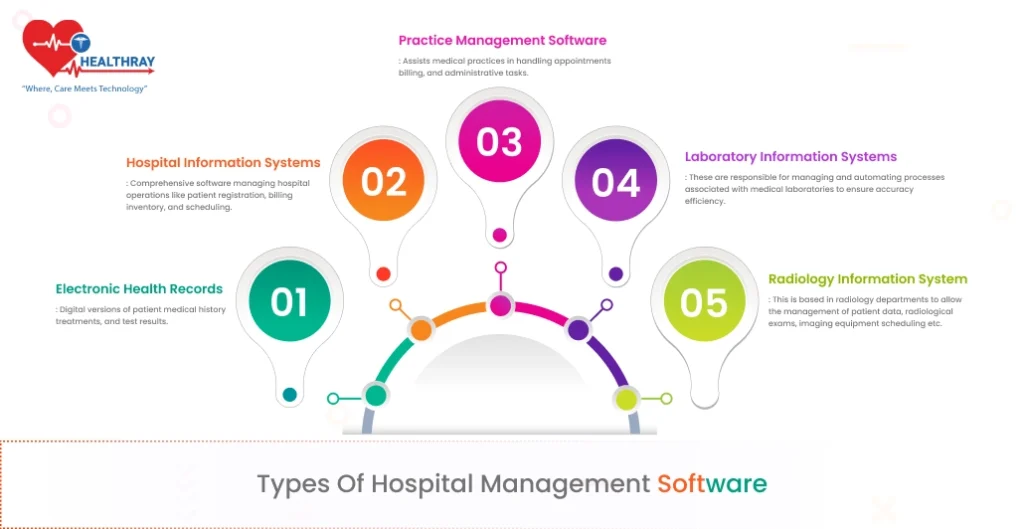
For understanding How To Create Hospital Management Software you should also know about the types of HMS. In this section we will discuss the types of HMS. Keep reading!
Electronic Health Records (EHR):Digital versions of patient medical history, treatments, and test results.
Hospital Information Systems: Comprehensive software managing hospital operations like patient registration, billing, inventory, and scheduling.
Practice Management Software: Assists medical practices in managing appointments, billing, and administrative tasks.
Laboratory Information Systems (LIS): These are responsible for managing and automating processes associated with medical laboratories to ensure accuracy and efficiency.
Radiology Information System: This is based in radiology departments to allow the management of patient data, radiological exams, imaging equipment scheduling etc.
Picture Archiving and Communication Systems (PACS): These systems store and retrieve medical images digitally. The system allows for viewing, sharing and storage of medical images.
Pharmacy Management Systems: These are designed to assist health facilities in handling medication-related issues which include tracking drug inventory, managing prescriptions, ensuring safe dispensing among others.
Patient Engagement and Portal Solutions: These enable patients’ participation in their own health through online portals by facilitating access to medical records as well as communication with healthcare professionals.
Revenue Cycle Management (RCM) Software: It improves the financial functions of a healthcare sector from billing process up to insurance claims so that revenue is maximized.
Nursing Information Systems (NIS): Assists nurses in managing patient data, care plans, and workflows.
Telemedicine and Telehealth Platforms: Enables remote medical consultations, laboratory tests, and monitoring.
Healthcare Analytics and Business Intelligence: Analyzes healthcare data for better decision-making.
Health Information Exchange (HIE) Platforms: Facilitates secure exchange of patient information among healthcare institutes.
Clinical Decision Support Systems (CDSS): Provides evidence-based guidance directly at the point of care.
Hospital Contract Management Software: Streamlines contract processes, automates approvals, and enhances compliance.
How to Create a Hospital Management Software?
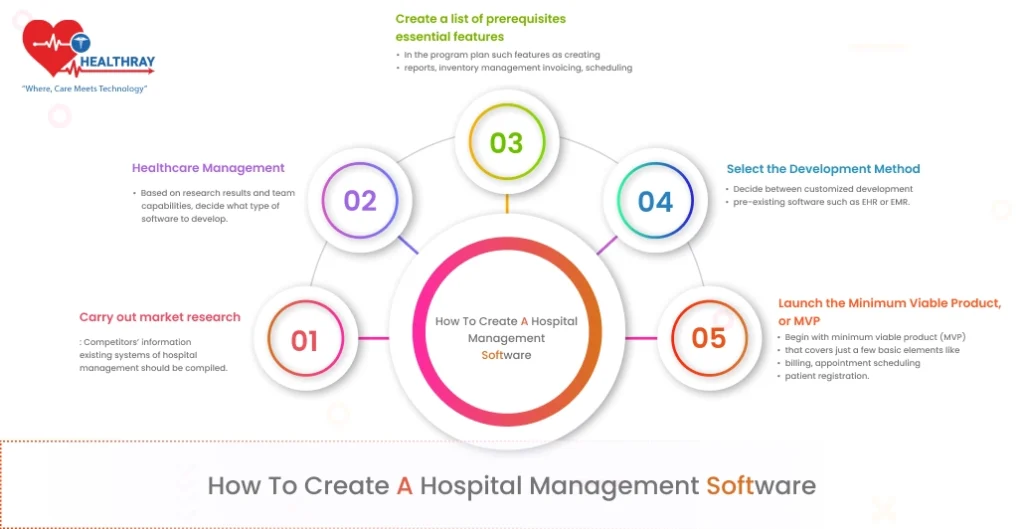
Here the steps to create a hospital management software:
Carry out market research
- Competitors’ information and existing systems of hospital management should be compiled.
- Market gaps are found, customer needs understood, a right pricing strategy is chosen.
Choose the Sort of Software for Healthcare Management
- Based on research results and team capabilities, decide what type of software to develop.
- Take care to select based on specific market requirements
Create a list of prerequisites and essential features
- As per plans, such features as creating reports, inventory management invoicing, scheduling appointments with patients among others.
- Think about permissions and user roles as different staff groups.
Select the Development Method
- Decide between customized development or pre-existing software such as EHR or EMR.
- While choosing, consider long-term supportability and scalability factors.
Launch the Minimum Viable Product, or MVP
- Begin with a minimum viable product (MVP) that covers just a few basic elements like billing, appointment scheduling and patient registration.
- Some necessitated changes are made after identifying issues from feedback provided by users.
Install the HMS
- Make sure that the hospital’s infrastructure has been established with all the needed hardware and network facilities.
- Do complete testing to identify and correct any faults or malfunctions.
- Train the hospital employees on how to use HMS using comprehensive documentation made.
- For minimizing interruptions, begin by slowly distributing it with a small user base.
- Watch out for system flaws during the early days, say a week or so.
- Start introducing its use throughout the hospital as soon as HMS stabilises.
Extra Things to Think About
- User-Friendly Interface: Make sure hospital personnel only need a minimal amount of training to use the interface.
- Scalability: Build the programme such that it can accommodate growing data and use as the hospital expands.
- Employ an iterative process to continuously improve the programme in response to user input.
- Strong security measures should be given top priority in order to safeguard private patient information.
- To guarantee that hospital personnel are using the HMS effectively, provide them with continual training and assistance.
- To help users comprehend and operate the product, create thorough manuals and documentation.
In what ways may Healthray assist you with creating software for hospitals?
Our company, Healthray, is here to help if you have any questions concerning the process of developing hospital administration software. Being one of the top providers of hospital management software development services in India, we have the know-how to help you every step of the way.
Our expertise lies in creating interfaces that are easy to use and include necessary functionalities like billing, booking appointments, patient data management, and more. Because of our knowledge, the software we create not only complies with industry requirements but also gives security first priority. Hence we are one of the best hospital management software development companies in India.
Our goal is to improve patient care and streamline hospital operations by using effective technological solutions. Make Healthray your first choice if you’re searching for a dependable development partner for hospital administration software. Please contact us if you have any questions or would like further details.
Conclusion
Now that our tutorial is coming to an end, perhaps you have all the answers to your questions on how to make hospital management software! While it may pose some challenges to follow, it is worthwhile to follow and create the HMS. As you just read, you may easily get in touch with us if you need assistance creating a hospital administration system.
